(A) After the spread of the Enclosures Act the majority of the inhabitants were landless. Many became framework knitters. One such was John Blackner, born in 1770. Apprenticed to a stocking maker at the age of 10, he would pass here with his future wife, Sarah Brown, and lived in Kirk Hallam. He was taught to read and write by a shoemaker. Blackner moved to Nottingham in 1792. He admired the revolution in France, mixing in the company of radicals who read the works of Tom Paine. He became a radical journalist in London, editing ‘The Statesmen’ and wrote for and edited ‘The Nottingham Review”. He found time to write a History of Nottingham and to became a publican. In later years some wrongly accused him of being ‘General Ludd’. He died in 1816 or may well have played a bigger part in our story.
Many more took this road to and from Nottingham, passing ‘The Gallows’ pub by the new Erewash canal at the bottom of the hill. Its name would remind many of the harsh punishments for those who got involved in radical politics or the machine breaking of the Luddites.
(B) Nottingham hosiers and middle-men in the villages controlled the trade and rented the frames. When wages were cut, machine breaking started from March 1811. Soon this reached Ilkeston with 200 frames smashed in three weeks. Attacks in Ilkeston restarted in November and continued into 1812. Luddism forged links across the two counties which were to influence the fight for reform in the coming years.
(C) In the 1790s militias were formed to oppose threatened French invasion but they could not be trusted to stop the machine breakers, so regular army soldiers were also stationed in village like Ilkeston. Militia members were often stockingers and shared the Luddites grievances.
(D) At The Anchor pub by late 1816 the conversation was less on machine breaking and now on demands for political rights for working people; for Universal Male Suffrage, Annual Parliaments and Vote by Ballot. At meetings of the Hampden Clubs they read William Cobbett’s ‘Political Register’ and ‘The Nottingham Review’.
Thousands signed a petition to Parliament but when it was dismissed there was talk of the need for revolution. Others, like the Ilkeston Club’s secretary John Graham, were against.
Thomas Bacon from Pentrich, the delegate for Derbyshire and Nottinghamshire to national meetings, was invited to join William Stevens of Nottingham at a meeting at the Anchor. Stevens, a needle maker from Nottingham, was leading member of the secret committee planning the Rising in Nottingham. By the end of April Bacon was busy making connections with radicals across Lancashire and Yorkshire, unaware that the Government had its own plans, with their spy ‘Oliver’ making his way to the Midlands.
(E) (You will pass The Erewash Museum at the corner with High Street, on your right. It is well worth a visit, with much of interest about local history, as well as toilets and refreshments. These streets were here in 1817 and stockingers who took part in the rising would have lived here. We only have a few names from dispositions given to magistrates after the Rising.
John Brown, member of Ilkeston Hampden Club, told others that the revolution was to start on 10th June. A former member of the Belper Militia, he led those from Ilkeston who went directly to Nottingham to join the revolutionary ‘army’ expected to be gathering on The Forest. When they found that they had been tricked Brown escaped north before returning to Lancashire and taking part in plans for a further Rising in 1820. It was again unsuccessful.
Luke Shipman returned from Nottingham on Monday 9th June and told John
Graham that the revolution would take place in Nottingham at 9 o’clock and would be ‘general across England’. He told Graham to take his men to Nottingham by 11pm.
Jesse Birkenshaw told John Fletcher of Heanor that the rising would be on 9th June
John Staples of Horsley said that John Brown approached him to join a new rising in 1819 because he had been in the militia with him and followed him to Nottingham in June 1817.
We do not know all who took part. No one from Ilkeston was prosecuted nor were any among those executed, imprisoned or transported. The Ilkeston men may have avoided this by going straight to Nottingham and not joining the march from South Wingfield and Pentrich.
(F) From the car park exit there is a view of the Erewash Valley and the route of the Rebels March as it crossed the valley from Langley Mill to Eastwood and on to Giltbrook where the rebels were met by soldiers and two magistrates.
(G) Looking down the street you can see the hills and woodland of Shipley Park. This was the estate of the Mundy family.
The Justice of the Peace, Mr Mundy, was one of those who led the soldiers to the Rebels. He questioned and charged those who were captured at the Sun Inn pub in Eastwood.
A Mundy also served as an M.P. and was on the Grand Jury at the Derby trial, which decided that the charge facing the prisoners was a capital offence of treason.














